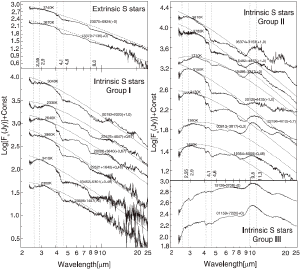|
S-type AGB stars
General issues
 | S stars are a group of red giants with
enhanced s-process elements (strong ZrO, LaO
lines, see Vanture & Wallerstain, 2002ApJ...564..395V).
If the enhanced s-process elements come from the red giants themselves, they
are intrinsic S stars and
are in a transitional phase in the AGB evolutionary sequence from M to S to
C stars. If, however, the enhanced s-process elements come from its
companion in a binary system, they are extrinsic S stars. A important characteristics
of intrinsic S star is the detectability of Tc lines
(because of the short lifetime of this unstable element), while extrinsic S
stars do not have (see Jorissen & Mayor, 1988A&A...198..187J,
1992A&A...260..115J). |
 | The General Catalogue of Galactic S Stars 2nd ED. (GCGSS2):
present all 1347 S stars known at that time. (Stephenson, 1984PW&SO...3....1S) |
 | Other ways to descriminate intrinsic and extrinsic S stars: (1) periodic radial velocity variation that indicates a binary
system (see Jorissen & Mayor, 1988A&A...198..187J,
1992A&A...260..115J);
(2) UV emission from hot WD companion in a
binary (see Johnson et al., 1990fmpn.coll..332J,
1993ApJ...402..667J);
(3) He I 1083nm line that only appear in stars
earlier than K type stars and thus should not appear in intrinsic S stars
(see Brown et al., 1990AJ.....99.1930B). |
Infrared Observations
 | They identifed USNO, MSX, 2MASS and IRAS counterparts of 528 S stars
(among 1347 S stars in GCGSS2). They used the combination of two color-color
diagrams [H-12]-[K-12] and [K-12]-[J-25] to statistically identify 256 candidate intrinsic and 147
candidate extrinsic S stars, thus increased the total number of
intrinsic and extrinsic S star candidates to 287 and 176, respectively.
(from Yang et al., 2006AJ....132.1468Y) |
 | They analyzed ISO SWS01 spectra of 17 S stars
(20 stars in total, but with the other 3 with bad ISO data quality). 15 of
these stars are intrinsic S stars while the rest 2 are extrinsic S stars.
They divided the intrinsic S stars into 3 groups (I, II, III) with
increasingly redder colors (i.e., increasing mass loss rates). S stars in
each group show similar SED shape. The group I
stars share similar SED with the 2 extrinsic S stars. They identified
molecular features as follows:
2.36-2.65um,
H2O+CO,
absorption,
2.66-3.38um,
H2O+CO2,
absorption,
2.90-3.30um,
HCN, absorption,
3.86-4.35um,
CS, absorption,
4.6um,
H2O+CO+CO2, absorption,
6.38-9.70um,
H2O, absorption,
8.4-15.6um,
dust, emission.
The dust feature show variable peak positions from 10.5um to longer than 11
um. (from Yang et al., 2007A&A...463..663Y)
(figs: ISO spectra of the 17 S stars,
grouped into I, II and III, according to increasing mass loss rate.)
 |
Molecular Observations
 | They surveyed 27 nearby (d<1kpc) S stars for their
CO,1-0, 2-1, HCN, 1-0, and SiO, 2-1 lines.
(from Bieging & Latter, 1994ApJ...422..765B) |
 | They detected HCN (0,1^1c,0) J=3-2 and (0,0,0) J=8-7 lines from the S star
Chi Cygni. The high excitation temperature of
these lines indicate that the emission should come from the inner CSE of the
star (within 20 R*). Therefore, it support the idea that
HCN is made by non-equilibrium chemistry in the shock regions close to the stellar
surface. (from Duari & Hatchell, 2000A&A...358L..25D) |
 | |
|
![]()